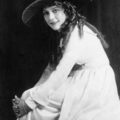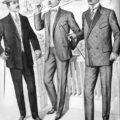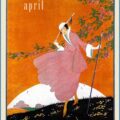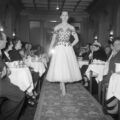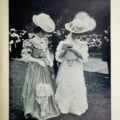1905 womens fashion – Lucile
January 19, 2016Lady Lucy Duff Gordon was one of Edwardian England’s most successful couturiers. She was also a striking, determined, scandalous and outrageous woman, given to acts of selfishness and vanity that are dubious even to modern sensibilities. She founded Maison Lucile in 1894 and here we have a pattern book showing her 1905 womens fashion, faithfully recording each of the designs from the year in watercolour along with samples of the fabric and trimmings they were made up in.
The house of Lucile dressed celebrities like Sarah Berhardt and Lillie Langtry, alongside the chicest of Londoners and Parisians, royalty and what were snobbishly known as “dollar princesses”, the exceedingly rich American women who dressed just as finely as any European royalty.
1905 womens fashion – silk and pearls
It’s probably just as well because these dresses, dripping in silk, pearls, metallic trims made from real silver and gold and swathes of hand made lace, were certainly no expense spared creations. Her aesthetic was a romantic one in soft pastel colours, although the odd design here is in stronger reds and dark blues, probably requested by the client herself. The black designs are made for those in mourning.
Duff Gordon made stage costumes as well as haute couture, and it was her massive cartwheel hat, worn by the famous actress Lily Elsie for a 1907 production of “the Merry Widow” that set the fashion for the huge hats with brims of up to three feet (about a metre) wide.
1905 womens fashion – opulent catwalk shows
Maison Lucile staged some of the first catwalk shows which were carefully produced affairs of live models circulating amongst guests, while a string quartet played and souvenir programmes given out to take home.
The house also produced not just dresses and ensembles in 1905 womens fashion, but perfume, bags, shoes, parasols and naughty lingerie of silk and ribbons, designed to seduce.
Speaking of seduction in 1905 womens fashion, Duff Gordon didn’t name her creations “Model no. X457”. Nope, she thought that it was better if they were called something more romantic, as satirical writer Marie Corelli noted on attending one of her shows.
‘Faint gigglings shook the bosoms of the profane as the “Incessant Soft Desire” glided into view, followed by “A Frenzied Song of Amorous Things,” – indeed, it would have been positively unnatural and inhuman had no one laughed.
Curious to relate, there were quite a large number of “gentlemen” at this remarkable exhibition of feminine clothes, many of them well-known and easily recognizable. Certain flaneurs of Bond Street, various loafers familiar to the Carlton “lounge,” and celebrated Piccadilly-trotters, formed nearly one half of the audience and stared with easy insolence at the “Red Mouth of a Venomous Flower” or smiled suggestively at “Incessant Soft Desire”. They were invited to stare and smile, and they did it. But there was something remarkably offensive in their way of doing it, and perhaps if a few thick boots on the feet of rough but honest workmen had come into contact with their smooth personalities on their way out of Madame Modiste’s establishment, it might have done them good and taught them a useful lesson.’
Marie Corelli, The Madness of Clothes; published in Free Opinions Freely Expressed, 1905
A shocking story
But was it just the outrageous names of her clothes in 1905 womens fashion and the saucy underwear she made that shocked society? Or was it that, as a society women herself with a title, Lady Duff Gordon engaged in a trade and mingled with actresses? Was it even that she’d married young, to an alcoholic husband who ran off with a chorus girl and who she then had the temerity to divorce before remarrying Lord Cosmo Duff Gordon? And to top it off, she rarely lived in the same house or even the same country as her husband. Well, all of these things were fascinating to an Edwardian audience in 1905 womens fashion. But what really left a nasty taste was Lord and Lady Duff Gordon’s behaviour during the sinking of the Titanic in 1912. Husband and wife both happened to be passengers on that fateful voyage. As the ship hit the iceberg, the couple leapt into the captain’s lifeboat, and, according to an inquiry into the matter later on, forced the crew to set off to safety although there were only 12 people in a boat with a capacity for 40. When the crew tried to turn around, Lord Duff Gordon allegedly paid them £5.00 (about £500 today) each to carry on. Lady Duff Gordon did herself no favours by writing a “humorous” and dismissive magazine article about her experience upon her safe return.
Lord Duff Gordon never really got over the shame of it, but Lady Duff Gordon carried resiliently on. Her fashion houses previously had successful branches in London and Paris, and when the war forced their closure she opened new stores in New York and Chicago. She herself wrote newspaper and magazine column and articles on fashion, and also fronted the British newsreel “Around the Town” (c. 1919–21).




